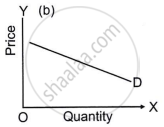Advertisements
Advertisements
Question
Match the following and select the correct option.
| Column I | Column II | ||
| (i) | Perfectly elastic demand | A. | Ed = 0 |
| (ii) | Perfectly inelastic demand | B. | Ed = ∞ |
| (iii) | Relatively elastic demand | C. | Ed < 1 |
| (iv) | Relatively inelastic demand | D. | Ed > 1 |
Options
(i) A, (ii) D, (iii) C, (iv) B
(i) A, (ii) B, (iii) D, (iv) C
(i) B, (ii) A, (iii) D, (iv) C
(i) D, (ii) C, (iii) A, (iv) B
Solution
(i) B, (ii) A, (iii) D, (iv) C
Explanation:
| Column I | Column II | ||
| (i) | Perfectly elastic demand | B. | Ed = ∞ |
| (ii) | Perfectly inelastic demand | A. | Ed = 0 |
| (iii) | Relatively elastic demand | D. | Ed > 1 |
| (iv) | Relatively inelastic demand | C. | Ed < 1 |
APPEARS IN
RELATED QUESTIONS
Answer the following question.
Explain the geometric method of calculating the elasticity of supply.
Which is the implication of a horizontal demand curve?
A demand curve which takes the form of a vertical line parallel to the price axis illustrates elasticity which is ______.
If elasticity of demand for salt is zero, and household demands 2 kg. of salt during one month when its price is ₹ 5 per kg., this household will demand the same quantity of salt even if price rises to ₹ 8 per kg.
Draw a diagram showing the Elasticity of demand less than one.
For each of the following, state whether it has inelastic demand or elastic demand:
- Luxury cars
- Life saving drugs
- Salt
- English textbook of class X
A perfectly elastic demand curve is parallel to the X-axis. Why or why not?
Indicate the degree of elasticity of demand of the following demand curve.

What is the price elasticity of demand for the following demand curve:
Straight line demand curve parallel to X-axis.
What is the price elasticity of demand for the following demand curve:
Straight line demand curve parallel to Y-axis.
